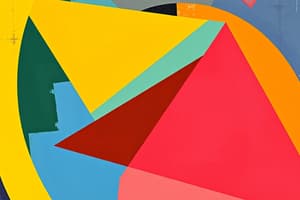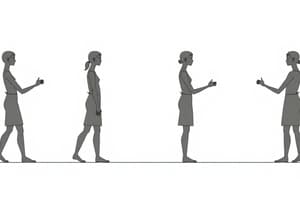Podcast
Questions and Answers
What will rotations, reflections, and translations of a geometric figure guarantee?
What will rotations, reflections, and translations of a geometric figure guarantee?
- They change the shape and size of the figure.
- They preserve congruence and similarity. (correct)
- They only work on two-dimensional figures.
- They are only used in algebraic expressions.
What is true about the effect of a sequence of rotations, reflections, and translations on a geometric figure?
What is true about the effect of a sequence of rotations, reflections, and translations on a geometric figure?
- It preserves congruence, because each individual transformation preserves congruence. (correct)
- It preserves congruence, but not similarity.
- It always changes the figure's size and shape.
- It never preserves congruence or similarity.
What is a result of a dilation of a two-dimensional figure?
What is a result of a dilation of a two-dimensional figure?
- The figure's shape changes, but its size remains the same.
- The figure's size changes, but its shape remains the same. (correct)
- The figure becomes a three-dimensional figure.
- The figure's size and shape remain the same.
What is a key aspect of using the coordinate system to describe transformations?
What is a key aspect of using the coordinate system to describe transformations?
What is a necessary condition for two figures to be similar?
What is a necessary condition for two figures to be similar?
Study Notes
Transformations and Congruence
- Rotations, reflections, and translations of a geometric figure preserve congruence, similar to how properties of operations preserve equivalence of arithmetic and algebraic expressions.
- A sequence of transformations can result in a congruent triangle, and this can be demonstrated using physical models, transparencies, geometric software, or other tools.
Properties of Transformations
- Rotations, reflections, and translations preserve congruence because they preserve:
- Line segments of the same length
- Angles of the same measure
- Parallel lines
- These properties can be verified experimentally.
Congruence and Similarity
- A two-dimensional figure is congruent to another if the second can be obtained from the first by a sequence of rotations, reflections, and translations.
- A two-dimensional figure is similar to another if the second can be obtained from the first by a sequence of rotations, reflections, translations, and dilations.
Using Coordinates
- The effect of dilations, translations, rotations, and reflections on two-dimensional figures can be described using coordinates.
Angle Properties
- The angle sum and exterior angle of triangles can be established using informal arguments.
- The angles created when parallel lines are cut by a transversal can be understood using transversals.
- The angle-angle criterion for similarity of triangles can be demonstrated using arrangements of triangles.
Studying That Suits You
Use AI to generate personalized quizzes and flashcards to suit your learning preferences.
Description
Explore how geometric transformations preserve congruence in triangles, using critical thinking and problem-solving skills. Use physical models and software to demonstrate a sequence of transformations resulting in a congruent triangle.




